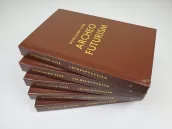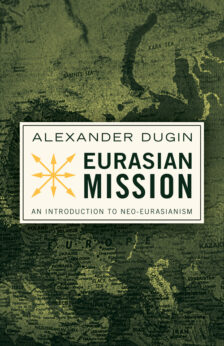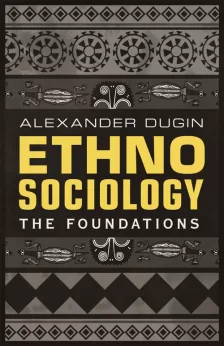The two aspects that drive holy evolution are what I call the creative (life) and competitive (death) impetuses. While wonder fuels the creative expansion of our perception, war spurs significant technological advancements. The detachment of the warrior function and abstraction of rulership in trader civilizations have been subsumed by a consumptive drive shaping human organization. We are now stuck in a negative feedback loop of the competitive survival impetus being hijacked for consumption, resulting in a destructive imbalance in the living chain of existence. Life requires a balance with death, and all things are sustained by their inverse. Seeing death as bad and life as good is short-sighted utopian idealism that harms the rebirth cycle. Losing personal, relational vantages supplants bonding formative processes with a universal vantage. Evolution is a holy formative process of Being and Becoming in a long and layering chain of living connection through life and death cycles of rebirth to grow and change, allowing for meaning.
Love and Life are distorted similarly by humanism and its extension in transhumanism, with the over-emphasis on all human life as sacred, which is not a part of natural formative processes. Love and Life are also both part of the creative impetus. Trying to save all life (an extension of the inversion of all human life) destroys the predator-prey ecology of life, wherein death is a meaningful and important component of life, just as veganism, through the requirements of vast farming combines, ends up killing many species to sustain. It is an inversion of the placement as apex and a desire to invert the entire foundations of life in the layering of the food chain. Only plastic or other things in their most entropic form outside the life and death cycle can be in a material stasis. To try to make a stasis of life out of something living destroys its essence. Just like with love, when it is not discerning, it destroys itself because everything is sustained by its inverse; even harmful simulacra manifest their own inverses. If you love everything without distinction, you destroy the formative processes of meaning and relational vantage of the living absolutes. Sustaining other groups is an example of this, and loss of protective instinct in the competitive impetus for consumptive expansion harms its inverse with the lack of love in the creative impetus. Ultimately, trying to love all or care for all life ends new life and love.
The sacrifice of energy needed to make the physical foil for the soul to house consciousness came with this risk and temptation to turn all life energy into the material, ending the gift of life by seeking to hold it in stasis. When the competitive impetus is misaligned, it fuels a consumptive mechanization that diminishes meaningful bonds that, in turn, increases the void and need to consume. Decadence supplants bonds with a material drive, emphasizing outward expansion through war and trade, perpetuating a cycle of insatiable consumption that will destroy the foundations of existence. The end state of this maximized entropy is the ultimate Stasis of Forms lacking the ability to live again because it is outside of the rebirth cycle. Taking something into a stasis in its most entropic form destroys its formative potential and capacity for meaning. To want to create a physical stasis is to end the potential of Being and Becoming, which was the entire purpose of creating the physical world through sacrifice as a foil for meaning.
As apex predators, we embody both primal instinct and higher consciousness. When these aspects detach from each other, a distorted expression of both emerges. In the Heroic Age of Europe, there was no separation of theism from deism, and their uncoupling parallels the uncoupling of the primal from higher consciousness or the creative impetus from the competitive impetus. The abstraction of theism that followed the fall of Archaic Dorian Greece to expanding empires was a product of the temptation to create a Stasis of Forms. Hence, the drive towards resurrection destroys reincarnation and rebirth. Revelation of the Vedas (pre-Hindu since Hinduism has consumptive distortions) expands on the processes of living existence. The oracular statements of Archaic Greece, barbarian Europe, and the Heroic Age were not disjointed from the continuum of the natural world. Revelation was a reading into the transmundane, realm of the gods, and ever-changing web of life present in the physical world behind the thin veil that some can bridge. Atheism is the inverse created by theism detaching from deism into a simulacrum of revelation that is antithetical to natural processes unique to monotheist religions from Egyptian materialistic influence on them, unlike Vedic revelation. Atheistic concepts of transhumanism are an extension of humanism and the final stages of the machine replacing God rooted in the simulacrum of theism in the first place.
War-Driven Technological Advancements Consumed in a Negative Feedback Loop
The nature of war transformed with the rise of material excess. Made possible by civilization, standing armies were used to expand outward with trade that collapsed on itself in the Bronze Age. What distinguished the European Heroic Age from the rest of the Bronze Age was their emphasis on war over trade, maintaining the proper bond of competitive impetus to the creative impetus and direct governance. The exponential relationship between war advancement, consumerist materialism, and decadent empires’ birth and death cycles in the following Iron Age is evident, accelerating once trader civilization subsumed the hero. Heroic societies became ensnared in this cycle when they conquered and held decadence, leading to the downfall of civilizations such as Sparta after holding Athens and solidified with Alexander the Great holding Persia. His similar form persists as the hero attempts to oppose the system from within but becomes utilized by it in turn. In the birth state of civilizations and empires, more heroic trends are present because the subsumed heroic cultures are the life force that fueled civilization or transmuted its death sentence, with a warrior figure rising in its high culture to either usher in the fall or transmute the death sentence folding into the next zeitgeist of the meta-zeitgeist.
Ever since trader civilization subsumed the heroic spirit, technological advancement in war reshapes human society, creating power vacuums that result in more conflict and repeat this process. Before the technological revolution, population growth and decline cycles facilitated the evolution from agrarian to industrial societies. The power vacuum stemming from the Industrial Revolution, characterized by technological advancements, mechanized transportation, interchangeable labor, and increased resource exploitation, fueled industrial warfare. The details might have been different, but industrialization caused the Great Wars. Wars are inevitable because leaps in technology and mechanized human systems create power vacuums at the top and destroy the strength and healthy epigenetics in the foundations. As societies are shaped around the consumptive wave of technology, sacrifices are made because they are ingrained in the system — industrialization first expanded the life it sacrificed in the subsequent war it necessitated. The development of computers during the world wars facilitated the technological revolution, enabling rapid population growth and mass movement in externally industrialized areas. Subsequent consumerist applications of this technology led to a significant societal shift, creating corresponding power vacuums and expanding external populations for the sacrificial culmination of globalism.
The solution does not lie in simply replacing individuals in positions of power or in blindly embracing technological advancement while ignoring its potential consequences. Both the masses and the elites are subject to these archetypal forces, which shape human organization. Instead, it requires a collective awareness of the shadow effects of our hijacked competitive impetus into the consuming void and pulling out of the system in a manner that speeds its collapse instead of being sacrificed to it, followed by a purposeful restructuring of human organization to differentiate between the creative and competitive impetuses. The influence of technology now extends beyond human organization, reaching into the transmundane, and operates in symbiosis with corrupt elites and globalization. Detached top-down power structures inherently tempt individuals, making it difficult for genuinely good people to occupy such positions, as power vacuums often attract the corrupt. The system itself resists producing or empowering individuals with the will and capability to fix it from within, as its corruptive aspects take on a life of their own, reinforcing a simulacrum that destroys healthy foundations.
Consumerist-driven technology has led to increased control by the elites and the simultaneous isolation and decline of the general populace, creating an inverse relationship between the quality of the average hominid and the evolution of a trader-globalizing civilization. The materialistic void, driven by unchecked technological advancement and hyper-production, fused the competitive impetus with consumption, ultimately consuming us and the creative impetus. Hyperproduction fuels consumerism, transcending political systems and manifesting in inverse relationships, such as between hyper-productive China and the hyper-consumptive West. Modern scientism lacks true creativity, as genuine creativity stems from a deep understanding of a living interconnected whole, creating and expanding the model that rationalization, compartmentalization, and categorization are recursive to.
The Mechanized Competitive Impetus in Scientism
Based on a realist ontology, deductive experiments reduce living interconnectedness to static parts to build models, undermining the essence of an objective vantage point. A true objective perspective of a living reality is relational and only possible when considering its entirety, including the observer. The sum of these experiments creates the illusion of an unbiased perspective when all objective vantages must be part of the whole truth. Our framing of an experiment influences how we perceive reality when using the results as a model. Experience, when grounded in the interwoven web of life, is the basis for framing experiments. Relativity and subjectivity are caused by the belief that statistics and experiments inherently have value outside of their framing; thus the framing becomes a blind spot where the unknown unknowns are hidden and compound when building models off of models. This abstraction now supplants the interconnected whole of living existence that the statistics and mathematical modeling show screenshots of — not only will our ability to measure always be limited but also the measurements must be understood as a screenshot of something non-static. The circular nature of these supposed objective screenshots being recursive to themselves then affects our own framing of reality.
Through the lived experience of many relational vantages integrating, we knew men and women as separate forms with unique essences long before the objective ability to prove it biologically. When the abstracted experimental proof replaces the relational experience, it then detaches the experience into the isolation of the simulacrum created by these objective screenshots, reducing it down to dead parts to build living wholes through an abstracted version of inductive reasoning which extends into the insanity of qualitative research. When the living chain of existence as our relational objective vantage of living absolutes is removed, experience becomes isolated simulacra that reflect the blind spot that our system inherently can have objectivity removed from the observer. All this does is continually hide the unknown unknowns in the premise of models as they build on themselves and we are more rapidly changed in living by the consumption of technics, causing many more compounding variables.
We have a sufficiently strong propensity not only to make divisions in knowledge where there are none in nature, and then to impose the divisions on nature, making the reality thus conformable to the idea, but to go further, and to convert the generalisations made from observation into positive entities, permitting for the future these artificial creations to tyrannise over the understanding.
— Henry Maudslay
Maudsaly was a mechanical genius who could see its limitations, which is the foundation of knowledge. It is not that engineering or technology is bad, it is that its limitations need to be understood. This is even more important now that the mechanical has bridged into the electrical with the ability to accelerate end-stage entropy. Our thinking and theories have become a house of cards of abstracting engineering methods into models with haphazard uses of inductive and deductive reasoning without anchoring. This has affected normative perception, so people even mistake integrative, non-linear processes in reality for isolated mechanizations. Just because a screenshot of wind can be understood through physics models does not reduce wind to a mechanization. When using living processes in mathematical and mechanical models, we must not supplant the original understanding of integrative reality with a screenshot of a measurement. This literally is the same as replacing living absolutes with just one relational objective vantage, which is far reduced compared to combining many relational objective vantages of a living whole to processed-based models of living absolutes. We arrived at a crisis of irreplicability from this material reductionist approach, where we apply methods developed for our inventions to all of living creation as if we have supplanted the living absolutes instead of being a part of them.
This loop of scientific and technological advancement is driven by consumption, lacking a living chain of existence. Thinking has been reduced to an accounting of terms or facts instead of broadening our understanding of an integrative reality. The driving forces of creative genius and technological innovation are completely antithetical and must be synergized in a manner conducive to life in its fullness. Most current worldviews are reduced to our recursive impersonalized quantitative research or the inverse it formed in isolated abstracted qualitative research instead of as something greater than ourselves, alive and integrative far beyond our comprehension that we can infer through processes built by constantly reintegrating relational vantages. This is the manner in which we should also understand traditionalism in its essence from the simulacrum of external customs. Before the heroic was subsumed, cultures exerted selective pressure via organizing by the living chain of their ancestors’ past forms and perceptual integration of absolute living realities in a state of constant growth and layering.
Regrounding Integrative Sciences from the Disconnect of Transhumanism and Gnosticism
Quantum theory has already reached the point of realizing something is wrong with applying modeling in a house of cards to the complexities of reality — the end of simulacrum will eat itself. However, they try to address these systemic issues by further abstracting. The problems are at the foundational levels and we need a process of understanding unknown unknowns and the limitations of mechanical experimental and statistical models. The processes of living absolutes need to be developed and redeveloped, with the underlying understanding that we will always miss some. We cannot build houses of cards that lead us to blindly fumble in the dark with the mysteries of the universe, looking at it in compartmentalization for use. Many of the experiments in recent years are toying with the secrets of the universe that we are not close to understanding with pointless hubris and reckless disregard for life and it makes perfect sense that the same system that shuts down for “safety” of all life would also allow the most ridiculous experiments to occur; they are the inverses consumptive desire to hold life in a material stasis of forms. At the foundations, we have replaced all the whats and whys with hows at increasingly smaller levels that do not let us understand the integrative living absolutes in reality. Everything in the web of life has an effect; it all affects each other and changes constantly in ways we are mostly blind to.
AI will only exacerbate these issues if they continue to be misunderstood in manners that confine our worldview instead of understanding its place as recursive to parameters of its given knowledge and not creative in the sense of being able to see outside of man’s current perception. AI can outcompete the competitive impetus but never the creative impetus, because it is not a gestalt living being created as a part of living absolutes and creative formative processes. AI reflects the competitive impetus’s self-recursion hijacked by the consuming void and will maximize its consumptive potential in our current system. If this is left unchecked and allowed to be driven by technology consumption, we will see that void consume the heroic lines, completely finalizing the transference of our life force into itself using Sedir. As the myth of Narcissus warns, if we do not snap out of the allure to fall into the reflection of our own competitive impetus, we will be consumed by it. AI can only be utilized if it is separated from this consuming void.
Transhumanism, like Gnosticism, seeks to escape isolated suffering of the material paradigm we created and blame it on the physical. Escaping to space is not the answer as the unknown unknowns are exponentially greater there than here. We have to reground not to escape into nature either but to be in balance with it to have a solid foundation to grow from. There is a balance between heaven and earth that we must find a place in and not give into short-sighted escapism of the responsibilities of this age. Long before we can go to space, we must retake our home base and create a method of integrating unknown unknowns here to help our ability to quantum leap in the face of exponentially greater unknowns in space. Technology has become a simulacrum in the way it is being used by a consumptive globalizing system to harm us all and even enslave and harm the best of those with competitive impetus, not just our warriors for the sake of trade. Brilliant, innovative men are an extension of the warrior with the same competitive impetus. Their detachment from the creative impetus causes them to grow cold understandably; thus transhumaism is not some state of evilness or a choice but a product of a disjointed natural process that needs regrounding. Like with Gnosticism, more detachment does not address the initial detachment at the root of this, so “the only way is through” is as ridiculous and irresponsible as “love is love” with the same end and why we see these disjointed inverses converge.
We have reached a new allegory of the cave. Let us say we long left Plato’s cave and came into the sun’s light. We saw the world through our eyes under the sun’s illumination and became so transfixed on the sun that we wanted to supplant it. We desired to find its secrets, to model them so that we could harness its power. We started to mine metals and other elements in caves, and spent so much time in cave networks looking at our own shadows made by the fire we carried with us that we started to think of the fire as the sun. The likeness of various parts of nature we could make with our own shadows we mistook for the vastness and profundity of the universe’s complexity. We dig deeper and deeper, getting lost in our own networks in these caves and so consumed with our own fire and desire to control and conform reality to our shadow modeling that we did not even realize the poisonous gas until it was too late. Continuing through this folly would lead to the entire mine network collapsing on all of our future generations and formative potential from the explosion.
Not forsaking the physical for the “spiritual” parallels not escaping into space but instead having responsibility to create a future, which denotes true spiritual strength. It is easy to say the spirit is greater than the material, it is harder to see that facing these challenges shows the interplay of the spirit in the physical. The root of Gnosticism is a circumventing of our own responsibility of dominion over nature as the apex of all apexes, to then blame the physical world for the material world we created — trying to then escape it and frame it as being spiritually superior with no sense of responsibility (not blame) to oppose the material void. You cannot fix a detachment with further detachment. Destroyers of worlds are the reason why there is the behavioral sink process to prevent recklessly consuming and wanting to escape the consequences. Gratefulness for the gift of life and the rebirth cycle demands sacrifice in the image of creation either towards your own line continuing or it will end it. The interplay of the competitive and creative impetus has a healthy balance in apex predators that allows them to evolve and a kill switch in those that become hyper-consumptive. Decadence harms the bonds that tie creative and competitive impetus into a synergistic evolutionary growing state for our species. This is why the Life Giver is the King of Kings; his competitive impetus makes the ultimate sacrifice to protect his people from the consuming void and the temptation of material stasis.









